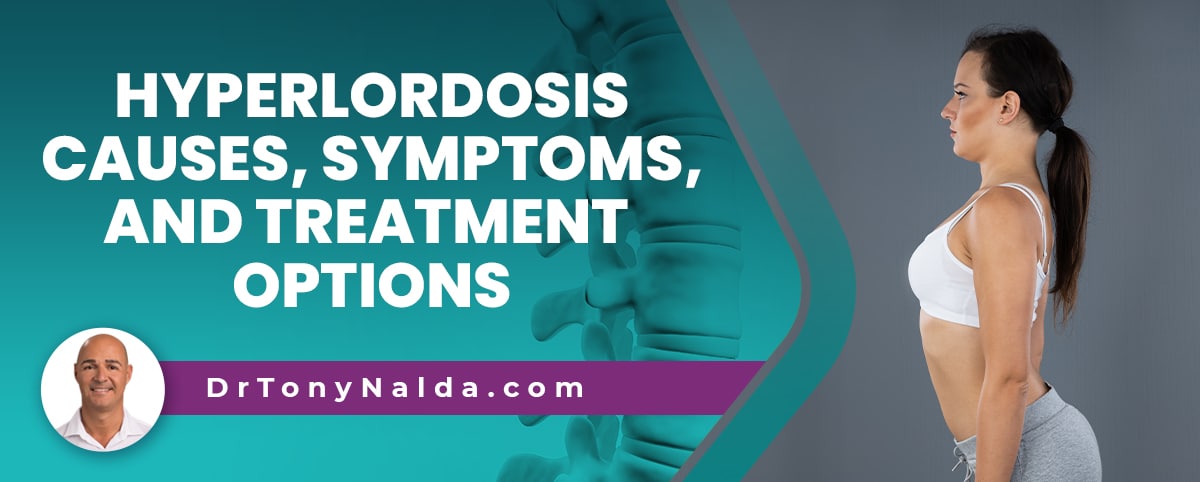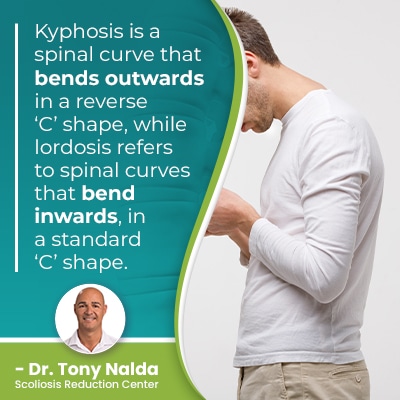Hyperlordosis Causes, Symptoms, and Treatment Options

In order for the spine to function optimally, it needs to maintain its natural curves because this means the spine is aligned in a straight and neutral position. When the spine loses one or more of its healthy curves, the entire spine is affected as its biomechanics are disrupted. Hyperlordosis can cause a swayback appearance as the buttocks and abdomen protrude excessively.
Being diagnosed with hyperlordosis means an exaggerated curve has developed in the lower back. Each spinal section has a healthy and characteristic curvature type, and if a curve becomes over-pronounced beyond a normal range, this can cause a number of problems.
Before getting to the specific causes, symptoms, and treatment of hyperlordosis, let’s first explore the roles and nature of the spine’s healthy curves.
Table of Contents
Healthy and Natural Spinal Curves
The spine’s natural and healthy curves give it a soft ‘S’ shape when viewed from the sides and will appear straight when viewed from the front and/or back.
The spine’s healthy curves make it stronger, more flexible, and facilitate its even absorption/distribution of mechanical stress incurred during movement.
If the spine loses one of its healthy curves, the integrity of its other curves are also affected as the health of each spinal curve is dependent on the others.
The spine has three main sections: cervical (neck), thoracic (middle/upper back), and lumbar spine (lower back), and each section has its characteristic curvature type, that either bends inwards, towards the body’s center, or outwards, away from it.
Kyphosis and Lordosis
 Kyphosis is a spinal curve that bends outwards in a reverse ‘C’ shape, while lordosis refers to spinal curves that bend inwards, in a standard ‘C’ shape.
Kyphosis is a spinal curve that bends outwards in a reverse ‘C’ shape, while lordosis refers to spinal curves that bend inwards, in a standard ‘C’ shape.
The lumbar and cervical spinal sections feature lordosis, while the thoracic spine has a natural kyphosis.
While there is a natural range of kyphosis and lordosis that can vary from person to person, if a person’s degree of curvature falls beyond a normal range, problems can occur.
What is Hyperlordosis?
Hyperlordosis is a spinal condition that involves the development of an excessive lordotic curve, and while this can occur at the cervical or lumbar spinal sections, it most commonly affects the lumbar spine.
The lumbar spine is particularly vulnerable to a number of spinal conditions/issues; while each spinal section has important functions, the lumbar spine has the added responsibility of supporting the weight of the trunk and the spinal sections above.
In addition, the vertebrae (bones of the spine) feel the effects of twisting, bending, and lifting motions, which is why most people will experience some degree of lower back pain throughout their lives.
So what are the causes of hyperlordosis?
Hyperlordosis Causes
Hyperlordosis can have different causes from postural issues to lifestyle factors and the presence of underlying spinal conditions, so let’s start with one of the most common: posture.
Posture
Chronic poor posture can affect the body in different ways, and as the spine allows us to stand upright and practice good posture, chronic poor posture can impact spinal health and function.
Excessive time spent sitting without keeping the shoulders back and spine straight can lead to tight muscles surrounding the lumbar spine, and over time, tight muscles and poor posture can shift the spine out of alignment and lead to an excessive inward curve.
Practicing good posture, and stretching regularly, helps keep the muscles that surround the spine loose, flexible, and strong.
When it comes to the spine’s ability to maintain its natural curves and alignment, its surrounding muscles play a large part.
Sedentary Lifestyle
Lifestyle factors such as low activity levels are also contrary to the spine’s movement-based design, and as a sedentary lifestyle doesn’t regularly use the spine’s surrounding muscles, they can become weak and incapable of supporting the spine, disrupting its ability to maintain its natural curves/alignment.
Obesity
Carrying excess weight can also strain the lumbar spine, especially if the extra weight is in the abdomen and lower body, which strains the joints of the body, including the spine, and also makes it harder for the spine’s surrounding muscles to provide the spine with optimal support as they too are strained.
Underlying Spinal Conditions
There are a number of spinal conditions that can cause the development of hyperlordosis, including kyphosis and discitis.
When an underlying spinal condition is the cause of the hyperlordosis, the larger spinal condition has to be the focus of treatment as hyperlordosis becomes a symptom and/or effect caused by another condition.
When the thoracic spine has hyperkyphosis (an exaggerated outward spinal curve), it can disrupt the spine’s alignment and cause the development of a compensatory curve, such as hyperlordosis of the lumbar spine below.
It’s not uncommon for the spine to respond to the destabilizing effect of an unnatural spinal curve by developing a compensatory curve to counteract the uneven forces introduced to the spine.
Discits is a condition caused by a viral or bacterial infection in the spinal discs.
Adjacent vertebrae of the spine are separated by an intervertebral disc, and disc issues are capable of causing a number of effects, symptoms, and spinal conditions to develop; this is because of the many roles played by the intervertebral discs including providing cushioning, acting as the spine’s shock absorbers, enabling flexible movement, and providing the spine with structure.
If a disc develops an infection, it can impact the health and function of the entire spine, particularly as adjacent vertebrae attach to the disc in between, so if a deteriorating disc changes shape, as is common, it can disrupt the position of adjacent vertebrae, making it difficult for the spine to keep its natural curves.
So now that we’ve defined the condition and explored some of its common causes, let’s address some common symptoms of hyperlordosis.
Symptoms of Hyperlordosis
 Symptoms of hyperlordosis can vary based on factors like patient age and overall health, causation, level of spinal flexibility, and condition severity.
Symptoms of hyperlordosis can vary based on factors like patient age and overall health, causation, level of spinal flexibility, and condition severity.
Common symptoms of hyperlordosis in the lumbar spine can include lower back and/or neck pain (compensatory curve), range of motion issues, an excessively-protruding abdomen and buttocks that give the body a swayback appearance.
When hyperlordosis is mild, the spine can maintain enough flexibility to counteract the pain and mobility issues that tend to be symptoms of severe hyperlordosis.
When hyperlordosis is severe, back and/or neck pain, movement restrictions, and noticeable postural changes are common.
Now, let’s discuss treatment options.
Hyperlordosis Treatment Options
When it comes to hyperlordosis, treatment options have to address the condition’s underlying cause.
When lifestyle and posture are the causes, treatment has to involve lifestyle guidance, changes, and addressing relevant postural issues.
Lumbar-stabilization exercises can help improve muscle strength so the muscles that surround the lumbar spine can help support and stabilize it, and they can also help with increasing flexibility and decreasing the load on the lower back.
When hyperlordosis is caused by another spinal condition, the underlying spinal condition has to be the focus of treatment; otherwise, hyperlordosis is only being addressed as a symptom of another condition, while its underlying cause goes unaddressed.
If hyperlordosis is a symptom of hyperkyphosis, the primary curve, the hyperkyphotic curve, has to be addressed first, so the compensatory hyperlordotic curve can be improved as the larger unnatural curve is reduced.
If a disc issue has caused the development of hyperlordosis, the health of the discs have to be restored, which can be worked towards through chiropractic care and physical therapy; as disc health is improved, spinal stabilization is improved as the misalignment is addressed on a structural level.
Here at the Scoliosis Reduction Center, I apply a conservative chiropractic-centered treatment approach that integrates multiple condition-specific treatment disciplines for the most specific and customized treatment results.
Conclusion
There are a number of spinal conditions a person can develop that involves a loss of its healthy curves and alignment.
A misaligned spine is one that can’t function optimally, and each spinal section has a characteristic curvature type known as kyphosis or lordosis.
Kyphosis is found in the thoracic spine as a curve that bends outwards, while lordosis is found in the cervical and lumbar spinal sections with curves that bend inwards.
While there are natural ranges of kyphosis and lordosis, if a person’s lordosis falls beyond a normal range, becoming excessive and over-pronounced, this can lead to a number of issues.
Hyperlordosis most commonly develops in the lumbar spine and can cause back pain, mobility issues, and postural changes commonly described as a swayback appearance: buttocks and abdomen protrude excessively.
When it comes to preserving spinal health and function, prevention is key; maintaining a healthy weight, activity level, practicing good posture, and understanding the ergonomics of heavy lifting can help prevent a number of spinal conditions, like hyperlordosis.
Dr. Tony Nalda
DOCTOR OF CHIROPRACTIC
After receiving an undergraduate degree in psychology and his Doctorate of Chiropractic from Life University, Dr. Nalda settled in Celebration, Florida and proceeded to build one of Central Florida’s most successful chiropractic clinics.
His experience with patients suffering from scoliosis, and the confusion and frustration they faced, led him to seek a specialty in scoliosis care. In 2006 he completed his Intensive Care Certification from CLEAR Institute, a leading scoliosis educational and certification center.
About Dr. Tony Nalda
 Ready to explore scoliosis treatment? Contact Us Now
Ready to explore scoliosis treatment? Contact Us Now





